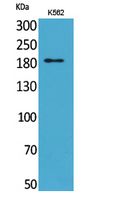
| WB | 咨询技术 | Human,Mouse,Rat |
| IF | 咨询技术 | Human,Mouse,Rat |
| IHC | 咨询技术 | Human,Mouse,Rat |
| ICC | 技术咨询 | Human,Mouse,Rat |
| FCM | 咨询技术 | Human,Mouse,Rat |
| Elisa | 1/20000 | Human,Mouse,Rat |
| Aliases | SIGLEC1; SN; Sialoadhesin; Sialic acid-binding Ig-like lectin 1; Siglec-1; CD169 |
| Entrez GeneID | 6614; |
| WB Predicted band size | 190kDa |
| Host/Isotype | Rabbit IgG |
| Antibody Type | Primary antibody |
| Storage | Store at 4°C short term. Aliquot and store at -20°C long term. Avoid freeze/thaw cycles. |
| Species Reactivity | Human |
| Immunogen | Synthesized peptide derived from the Internal region of human CD169. |
| Formulation | Purified antibody in PBS with 0.05% sodium azide,0.5%BSA and 50% glycerol. |
+ +
以下是关于CD169抗体的3篇参考文献及其摘要内容的简要概括:
1. **文献名称**:*CD169+ macrophages regulate PD-1/PD-L1 checkpoint inhibition in cancer immunotherapy*
**作者**:Sheng J, et al.
**摘要**:该研究探讨了CD169+巨噬细胞在肿瘤免疫治疗中的作用,发现其通过调控PD-1/PD-L1信号通路增强T细胞抗肿瘤活性。CD169抗体的应用可特异性标记并激活此类巨噬细胞,为联合免疫治疗提供新策略。
2. **文献名称**:*CD169 mediates SARS-CoV-2 entry and pathogenesis in human macrophages*
**作者**:Zhu L, et al.
**摘要**:研究揭示了CD169作为SARS-CoV-2病毒进入巨噬细胞的受体机制,利用CD169抗体阻断实验证实其参与病毒内吞和炎症因子释放,为COVID-19的宿主靶向治疗提供依据。
3. **文献名称**:*CD169+ lymph node macrophages enforce CD8+ T cell tolerance in autoimmune disease*
**作者**:Asano K, et al.
**摘要**:该文献报道了CD169+淋巴结巨噬细胞通过递呈自身抗原抑制CD8+ T细胞过度活化,使用CD169抗体敲除此类细胞会加剧自身免疫反应,提示其在维持免疫耐受中的关键作用。
以上文献均聚焦于CD169在不同免疫场景中的功能机制及抗体应用的实验验证,涵盖肿瘤、病毒感染和自身免疫疾病领域。
CD169. also known as Siglec-1 or sialoadhesin, is a transmembrane protein belonging to the sialic acid-binding immunoglobulin-like lectin (Siglec) family. It is primarily expressed on specific subsets of macrophages, including those in lymphoid tissues like lymph nodes and spleen. Structurally, CD169 contains an N-terminal V-set immunoglobulin domain that mediates binding to sialylated glycans on cell surfaces or pathogens, followed by multiple C2-set domains. This lectin-like interaction enables CD169 to play roles in cell-cell adhesion, immune modulation, and pathogen recognition.
CD169+ macrophages are strategically positioned in tissues to capture antigens and interact with lymphocytes, facilitating immune responses. Studies highlight their involvement in viral infections (e.g., HIV), where CD169 promotes viral uptake and trans-infection of T cells. CD169 antibodies, developed as research tools, help identify these macrophages and investigate their functions in diseases. For instance, anti-CD169 antibodies are used to block interactions in vitro or track cellular localization in vivo. Emerging evidence suggests therapeutic potential, such as targeting CD169 to modulate antigen presentation or inflammation, though applications remain exploratory.
Overall, CD169 antibodies serve as critical reagents for dissecting macrophage biology and its implications in infection, cancer, and autoimmune disorders.
×